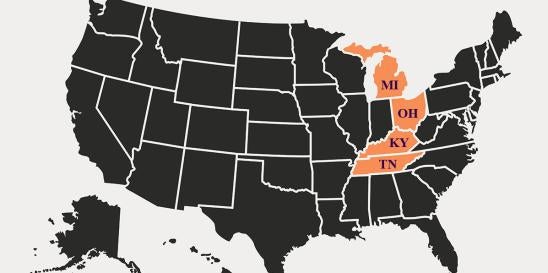Yesterday evening, the Sixth Circuit issued a blockbuster decision in consolidated cases addressing the constitutionality of Tennessee’s and Kentucky’s laws limiting minors experiencing gender dysphoria from certain sex-transition treatments. Chief Judge Sutton wrote the majority opinion, which Judge Thapar joined. Judge White dissented. The majority and dissenting opinions cumulatively span over 70 pages.
Individuals who have gender dysphoria experience a “lack of alignment between their biological sex and perceived gender.” Majority Op. at 4. The Tennessee and Kentucky laws are concerned with the types of medical procedures that healthcare providers might prescribe minors suffering from gender dysphoria. Under both States’ laws, medical providers are generally banned from performing sex-transition surgeries for such minors. Medical providers likewise cannot administer puberty-blocking hormones for such minors.
This decision is not the first that this Panel has issued in these cases. After the District Court in the Tennessee case issued a preliminary injunction against enforcement of the Tennessee law, Tennessee appealed and the Panel — the same one that issued yesterday’s decision — stayed the injunction pending appeal. See L.W. ex rel. Williams v. Skrmetti, 73 F.4th 408 (6th Cir. 2023). Although the District Court in the Kentucky case likewise issued a preliminary injunction against enforcement of the Kentucky law, the District Court issued a stay of its decision and the Panel declined to lift it. See Doe 1 v. Thornbury, 75 F.4th 655, 656–57 (6th Cir. 2023) (per curiam). Like she did yesterday, Judge White dissented from both of the stay decisions. The stay decisions provided a window into the Sixth Circuit’s thinking on the constitutional issues and strongly suggested that the Court was gearing up to reverse both preliminary injunctions (which the Court did yesterday). But yesterday’s opinions expanded the Court’s analysis from the stay stage by about 50 pages and, naturally, covered a lot more ground than those earlier decisions.
With that bit of procedural history out of the way, it’s time to discuss what the opinions said. As I’ve been hinting, they said a lot. In a nutshell, the challengers levelled several constitutional arguments against the laws and in support of the preliminary injunctions entered in the cases. The Majority rejected each argument and concluded that the challengers had not shown they were likely to prevail on the merits. To be a little more specific, the plaintiffs’ constitutional arguments fell into two broad categories: (1) those based on the Fourteenth Amendment’s Due Process Clause, and (2) those based on the Fourteenth Amendment’s Equal Protection Clause. Long story short, the Majority found neither category of argument availing; the Dissent reached the opposite conclusion for both categories.
In so doing, the Panel navigated familiar doctrinal rubrics: among others, whether the asserted rights are “deeply rooted in this Nation’s history and tradition,” and whether Tennessee’s and Kentucky’s laws are premised on “protected classifications.” Both the Majority and Dissent marshalled a large amount of caselaw in support of their respective opinions, drawing analogies and distinctions in the common-law-like manner that often characterizes constitutional reasoning.
In a short blog post (and this one must be short), I cannot do justice to the many intricate points addressed in the opinions, but I’ll flag one overarching theme that I believe animates much of the reasoning (and, ultimately, disagreement) between the Majority and the Dissent. I am referring to the opinions’ differing conceptions of the proper role of the federal courts in our constitutional democracy where power is separated not just horizontally (between the different branches of government) but also vertically (between the federal and state governments).
Over and over, the Majority stresses the limited role the federal courts must play in addressing a contentious social issue that also implicates an area of “medical and scientific uncertainty.” Majority Op. at 14 (quoting Gonzales v. Carhart, 550 U.S. 124, 163 (2007)). For the Majority, “that is precisely the kind of situation in which life-tenured judges construing a difficult-to-amend Constitution should be humble and careful about announcing new substantive due process or equal protection rights that limit accountable elected officials from sorting out these medical, social, and policy challenges.” Majority Op. at 40. What sounds like judicial modesty to the Majority sounds like judicial abdication to the Dissent — at least where, in the Dissent’s view, “a fundamental right or freedom from discrimination is involved,” which the Dissent believed was the case here. Dissent Op. at 73. “‘The very purpose of’ our constitutional system, the Dissent reasoned, ‘was to withdraw certain subjects from the vicissitudes of political controversy, to place them beyond the reach of majorities and officials and to establish them as legal principles to be applied by the courts.'” Id. (quoting W. Va. St. Bd. of Ed. v. Barnette, 319 U.S. 524, 538 (1943)).
Of course, where to draw the line between fundamental rights that should be free from the “vicissitudes of political controversy” and policy choices that should be left to “accountable elected officials” is one of those perennial questions in constitutional law to which no answer yields complete agreement. Even in the absence of such unanimity, however, we can take heart in knowing that the debates over such questions are continuously enriched by thoughtful opinions like the ones issued in these cases.




 i
i


